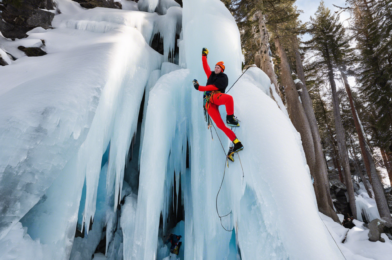Footwork is fundamental in ice climbing. Learning how to properly kick your feet into the ice to create secure footholds is essential. Practice different kicking techniques, such as front pointing, where your crampons are pointed straight down, providing a stable platform for balance. Side pointing involves driving your feet into the ice at an angle, creating a comfortable stance and reducing fatigue. You can also try flat-footing, placing your entire foot firmly on the ice for a more relaxed stance when climbing low-angle slopes or resting.
Using your ice tools effectively is another critical skill. Practice different swinging techniques to drive your tool’s picks into the ice securely. A straight, downward swing is useful when climbing steep sections, while a lateral swing can help you gain more purchase on less vertical terrain. Learn the “figure four” technique, where you cross your tools in front of you for better balance and stability. Always remember to keep your arms relaxed and shoulders down to conserve energy and prevent fatigue.
Belaying, the technique of managing the climbing rope to catch a falling climber, is a crucial skill for safety. Familiarize yourself with different belay techniques and practice them diligently. Master the art of rope handling, keeping it taut without causing hindrance to the climber. Be vigilant and watch the climber’s movements, ready to brake and arrest a fall. It is also essential to communicate actively with your climbing partner, ensuring smooth and safe climbing.
Ice climbing involves ascending and descending ropes, so learning proper rope techniques is vital. Practice ascending a fixed line, using techniques like the “frog climb” or “rope walk.” For descending, know how to set up a rappel and control your speed with proper braking techniques. Always use a backup system, such as an autoblock, for added safety. Understanding rope work will give you the confidence to tackle more advanced climbs.
Safety is paramount in ice climbing, and knowing when and how to place protective gear is essential. Practice placing ice screws efficiently and effectively. Learn to identify solid ice and understand the different types of placements. Be aware of the angles and directions your screws should face for maximum security. Always back up your protection with additional gear or a solid belay stance to minimize the risk of injury in case of a fall.
Climbing efficiently requires conserving energy and minimizing unnecessary movements. Smooth, deliberate motions will help you climb longer without tiring. Plan your moves ahead to create a fluid climbing motion. Avoid over-gripping your tools, as this wastes energy. Instead, focus on relaxing your hands and arms, keeping them loose and flexible. Climbing efficiently also means breathing properly. Take deep breaths to oxygenate your muscles and maintain a steady pace.
Mental toughness and focus are crucial for success in ice climbing. The sport demands concentration, quick decision-making, and a positive mindset. Stay focused on the task at hand, assess the conditions, and make split-second decisions confidently. Visualize your climb before you start, and maintain a positive attitude throughout. The ability to keep a clear head and stay determined will help you conquer challenging routes and overcome fear or hesitation.









